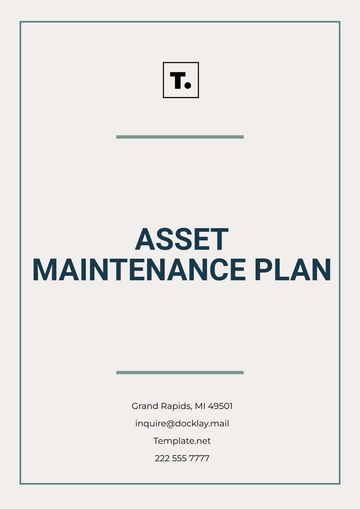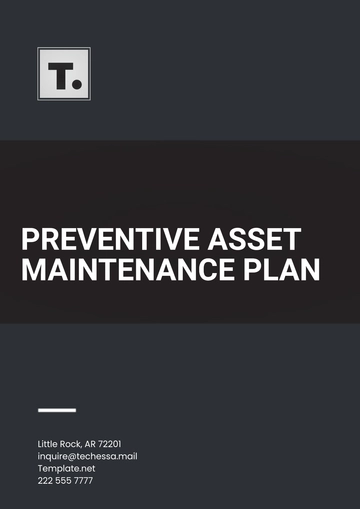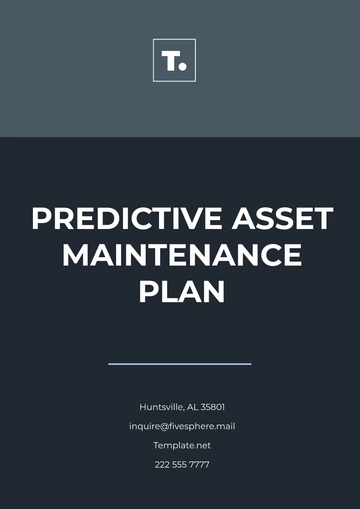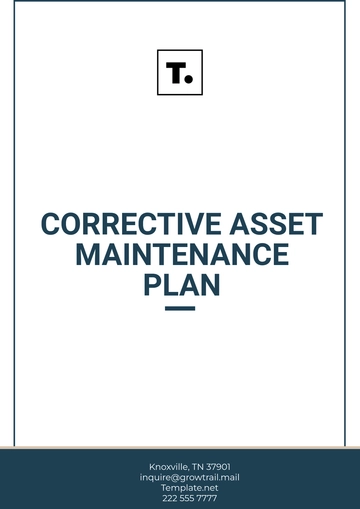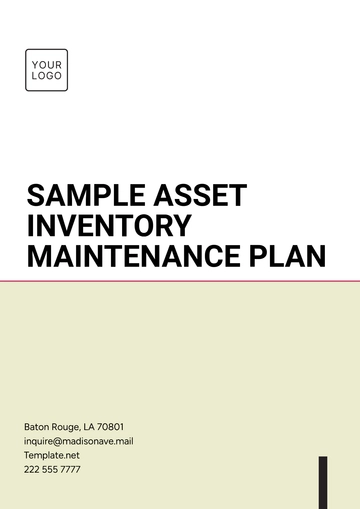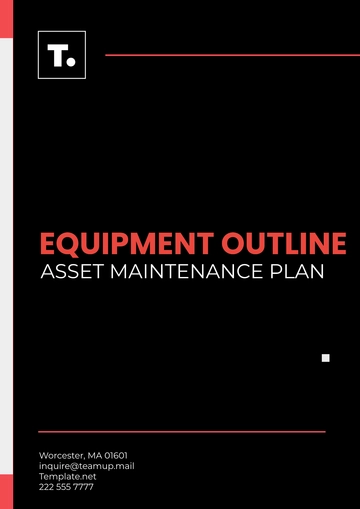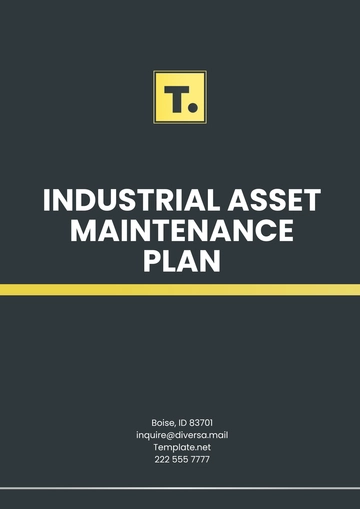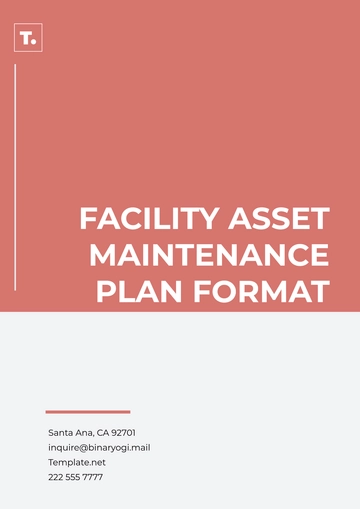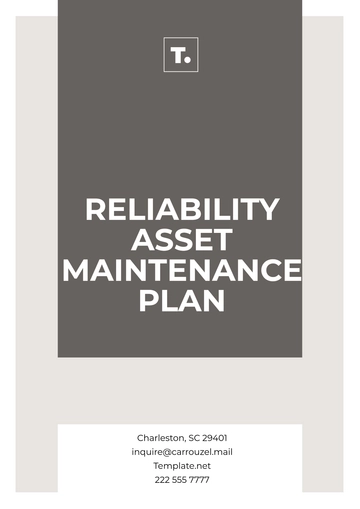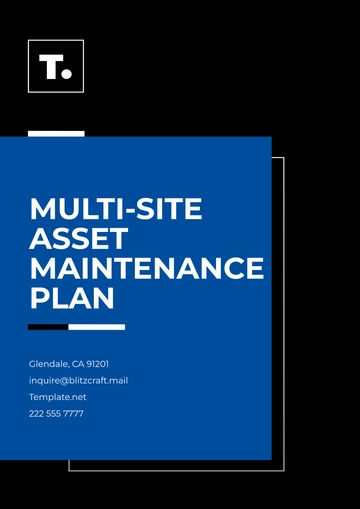Free Predictive Asset Maintenance Plan
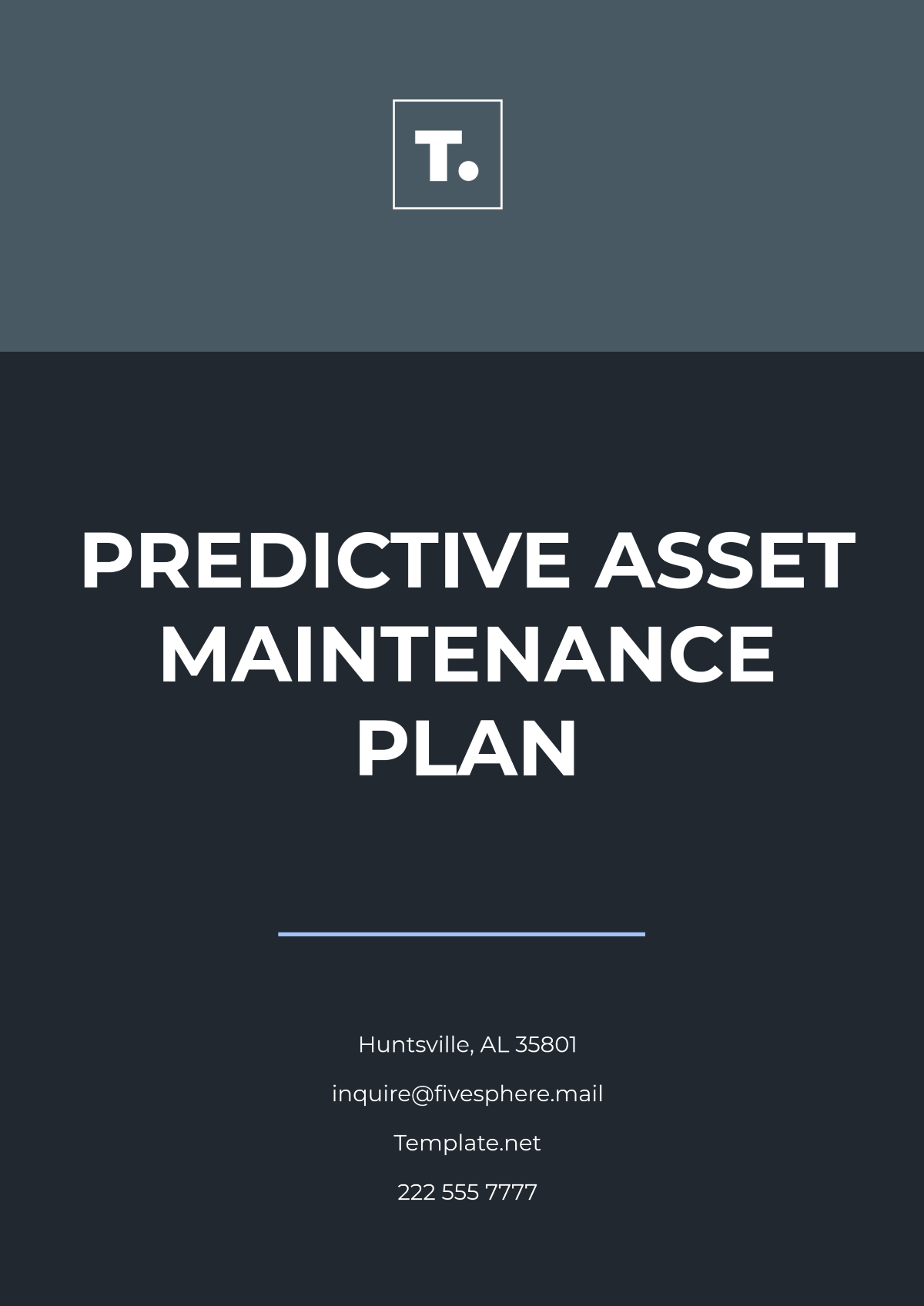
Prepared by: [Your Name]
Company: [Your Company Name]
Date: [Date]
I. Introduction
The Predictive Asset Maintenance Plan is a forward-thinking approach aimed at optimizing the longevity and efficiency of essential equipment through the application of predictive analytics and real-time monitoring of performance data. This proactive strategy seeks to reduce unforeseen breakdowns, minimize costly downtime, and ensure smoother operational workflows by analyzing both historical data and real-time metrics. By identifying patterns and trends that indicate potential failures, organizations can plan for necessary interventions well in advance, ensuring operational efficiency and cost savings.
II. Asset Inventory
Identifying and organizing critical assets within an organization allows for more efficient management of maintenance activities. By creating a comprehensive inventory of all assets and categorizing them based on their importance and condition, businesses can prioritize maintenance tasks, allocate resources effectively, and extend the useful life of equipment.
Table 1: Critical Assets Overview
Asset ID | Asset Name | Location | Condition | Last Maintenance Date |
|---|---|---|---|---|
001 | Conveyor Belt A | Warehouse 1 | Operational | March 20, 3050 |
002 | Boiler C | Plant 4 | Operational | May 02, 2050 |
003 | Hydraulic Pump D | Workshop 3 | Minor wear | January 28, 2050 |
004 | Air Conditioning B | Building 5 | Operational | April 18, 2050 |
005 | Generator E | Factory 6 | Needs Inspection | June 10, 2050 |
By maintaining a clear asset inventory, organizations can tailor their maintenance schedules and allocate resources more effectively, ensuring critical equipment remains operational and well-maintained.
III. Data Collection & Monitoring
A. Sensor Deployment
To support the predictive maintenance model, sensors are strategically deployed on key assets to collect real-time performance data. These sensors track various operational parameters such as vibration levels, temperature fluctuations, and pressure changes. The continuous monitoring of these metrics helps to detect early signs of wear and tear, ensuring that maintenance teams can take corrective actions before a failure occurs.
B. Data Management System
The integration of a robust data management system is crucial for the efficient handling and analysis of the vast amounts of data generated by the sensors. A centralized system collects, stores, and processes real-time and historical data for further analysis. This enables seamless access to relevant information across departments and ensures that decision-makers have the data they need to take proactive action.
Real-time Data Logging: Constant logging of operational data helps capture minute changes in asset performance, allowing for timely interventions.
Historical Data Analysis: By analyzing past performance trends, organizations can identify recurring issues and forecast future maintenance needs.
Data Cleaning and Preprocessing: Ensuring that data is accurate, consistent, and free of errors is crucial for reliable predictive analysis.
IV. Predictive Analytics Methodology
A. Machine Learning Models
Leveraging machine learning techniques, predictive models are created to recognize patterns and predict the likelihood of asset failure. By applying algorithms to the collected data, these models can identify trends that human inspectors might overlook, allowing for more accurate forecasts and maintenance scheduling.
B. Data Analysis Techniques
Several data analysis methods are employed to enhance the predictive maintenance process, including:
Regression Analysis: Used to understand the relationship between operational parameters and equipment performance over time.
Anomaly Detection: Helps identify outliers in asset behavior that may indicate an impending failure.
Time-Series Analysis: Focuses on historical data patterns to forecast potential breakdowns and optimize maintenance windows.
V. Maintenance Strategies
A. Scheduled Maintenance
Scheduled maintenance refers to performing routine inspections or interventions based on predictions from the analytics model. These activities are scheduled at specific intervals to address potential wear and tear before it results in operational failure.
Proactive Inspections: Ensuring that maintenance activities align with predicted failure timelines.
Preventive Tasks: Replacing or lubricating parts that are predicted to wear out soon.
B. Condition-Based Maintenance
Condition-based maintenance occurs when real-time data shows a deviation from normal operating parameters. In such cases, maintenance is conducted immediately to prevent further damage and avoid more expensive repairs down the line. This strategy ensures that resources are focused on areas where they are needed most, avoiding unnecessary interventions.
Real-Time Adjustments: Responding to data anomalies and executing immediate corrective actions as needed.
Continuous Monitoring: Ensuring constant supervision of critical equipment and adjusting maintenance schedules accordingly.
VI. Risk Management
A. Risk Assessment
Identifying potential risks associated with equipment failure is crucial in any maintenance plan. Predictive analytics help assess the probability of failure and its possible impact on operations. Risk assessment includes evaluating both the likelihood of failure and the financial or operational consequences that might arise from it.
Risk Identification: Examining failure modes and their effects on operations.
Impact Analysis: Understanding how a failure could disrupt production or increase costs.
B. Mitigation Strategies
Developing risk mitigation strategies ensures that organizations are prepared for unforeseen maintenance needs or catastrophic failures. This may include:
Contingency Plans: Creating backup systems or plans to keep operations running during an unexpected breakdown.
Resource Allocation: Setting aside budgets and manpower to address emergency maintenance requirements.
VII. Performance Metrics
Key Performance Indicators (KPIs)
Establishing KPIs is essential for tracking the effectiveness of the Predictive Asset Maintenance Plan. The following metrics are commonly used to assess performance:
Mean Time Between Failures (MTBF): Measures the average time between failures for a particular asset. A higher MTBF indicates a more reliable asset.
Mean Time To Repair (MTTR): Calculates the average time required to repair a failed asset. The goal is to minimize MTTR, ensuring swift recovery from any downtime.
Asset Utilization Rate: Tracks how efficiently assets are being used. High utilization rates suggest optimal performance and resource allocation.
Cost Savings: Analyzes the reduction in maintenance and operational costs resulting from predictive maintenance compared to reactive strategies.
VIII. Conclusion
A well-structured Predictive Asset Maintenance Plan is a critical tool for enhancing the reliability of assets, maximizing asset utilization, and minimizing operational disruptions. By integrating data-driven insights and predictive analytics, organizations can move away from traditional reactive maintenance approaches, instead adopting a proactive and more efficient maintenance strategy that leads to improved operational efficiency and cost-effectiveness. As industries continue to evolve, predictive maintenance strategies will remain essential for ensuring the longevity and optimal performance of assets across sectors.
- 100% Customizable, free editor
- Access 1 Million+ Templates, photo’s & graphics
- Download or share as a template
- Click and replace photos, graphics, text, backgrounds
- Resize, crop, AI write & more
- Access advanced editor
Leverage data-driven insights with the Predictive Asset Maintenance Plan Template from Template.net. This editable and customizable plan allows you to integrate predictive maintenance strategies, using asset data to anticipate issues before they arise. Fully editable in our Ai Editor Tool, you can personalize it to align with your specific equipment and maintenance protocols, improving reliability and reducing downtime.
You may also like
- Finance Plan
- Construction Plan
- Sales Plan
- Development Plan
- Career Plan
- Budget Plan
- HR Plan
- Education Plan
- Transition Plan
- Work Plan
- Training Plan
- Communication Plan
- Operation Plan
- Health And Safety Plan
- Strategy Plan
- Professional Development Plan
- Advertising Plan
- Risk Management Plan
- Restaurant Plan
- School Plan
- Nursing Home Patient Care Plan
- Nursing Care Plan
- Plan Event
- Startup Plan
- Social Media Plan
- Staffing Plan
- Annual Plan
- Content Plan
- Payment Plan
- Implementation Plan
- Hotel Plan
- Workout Plan
- Accounting Plan
- Campaign Plan
- Essay Plan
- 30 60 90 Day Plan
- Research Plan
- Recruitment Plan
- 90 Day Plan
- Quarterly Plan
- Emergency Plan
- 5 Year Plan
- Gym Plan
- Personal Plan
- IT and Software Plan
- Treatment Plan
- Real Estate Plan
- Law Firm Plan
- Healthcare Plan
- Improvement Plan
- Media Plan
- 5 Year Business Plan
- Learning Plan
- Marketing Campaign Plan
- Travel Agency Plan
- Cleaning Services Plan
- Interior Design Plan
- Performance Plan
- PR Plan
- Birth Plan
- Life Plan
- SEO Plan
- Disaster Recovery Plan
- Continuity Plan
- Launch Plan
- Legal Plan
- Behavior Plan
- Performance Improvement Plan
- Salon Plan
- Security Plan
- Security Management Plan
- Employee Development Plan
- Quality Plan
- Service Improvement Plan
- Growth Plan
- Incident Response Plan
- Basketball Plan
- Emergency Action Plan
- Product Launch Plan
- Spa Plan
- Employee Training Plan
- Data Analysis Plan
- Employee Action Plan
- Territory Plan
- Audit Plan
- Classroom Plan
- Activity Plan
- Parenting Plan
- Care Plan
- Project Execution Plan
- Exercise Plan
- Internship Plan
- Software Development Plan
- Continuous Improvement Plan
- Leave Plan
- 90 Day Sales Plan
- Advertising Agency Plan
- Employee Transition Plan
- Smart Action Plan
- Workplace Safety Plan
- Behavior Change Plan
- Contingency Plan
- Continuity of Operations Plan
- Health Plan
- Quality Control Plan
- Self Plan
- Sports Development Plan
- Change Management Plan
- Ecommerce Plan
- Personal Financial Plan
- Process Improvement Plan
- 30-60-90 Day Sales Plan
- Crisis Management Plan
- Engagement Plan
- Execution Plan
- Pandemic Plan
- Quality Assurance Plan
- Service Continuity Plan
- Agile Project Plan
- Fundraising Plan
- Job Transition Plan
- Asset Maintenance Plan
- Maintenance Plan
- Software Test Plan
- Staff Training and Development Plan
- 3 Year Plan
- Brand Activation Plan
- Release Plan
- Resource Plan
- Risk Mitigation Plan
- Teacher Plan
- 30 60 90 Day Plan for New Manager
- Food Safety Plan
- Food Truck Plan
- Hiring Plan
- Quality Management Plan
- Wellness Plan
- Behavior Intervention Plan
- Bonus Plan
- Investment Plan
- Maternity Leave Plan
- Pandemic Response Plan
- Succession Planning
- Coaching Plan
- Configuration Management Plan
- Remote Work Plan
- Self Care Plan
- Teaching Plan
- 100-Day Plan
- HACCP Plan
- Student Plan
- Sustainability Plan
- 30 60 90 Day Plan for Interview
- Access Plan
- Site Specific Safety Plan
